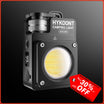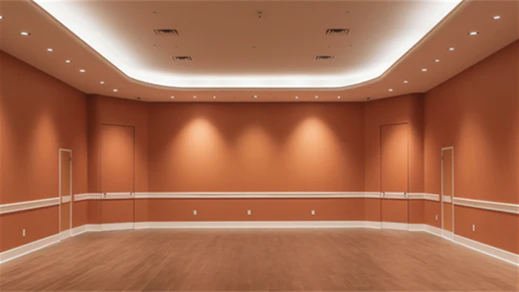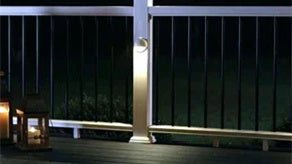Can lights and recessed lighting are both popular choices for illuminating spaces in residential and commercial settings. While they serve similar purposes, there are key differences between the two that can influence your lighting decisions. In this guide, we will explore the characteristics, advantages, and disadvantages of can lights and recessed lighting to help you make informed choices for your lighting needs.
1. What are Can Lights?
- Definition and Overview: Can lights, also known as pot lights or downlights, are fixtures installed into hollow openings in ceilings. They are designed to be flush with the ceiling surface, creating a sleek and unobtrusive appearance.
- Construction and Design: Can lights typically consist of a housing, trim, and light bulb. The housing is installed above the ceiling, while the trim covers the opening and directs the light downward. They come in various sizes and shapes to accommodate different ceiling types and design preferences.
- Installation Process: Can lights require creating an opening in the ceiling, running wiring, and securing the housing in place. Installation may involve cutting into the ceiling material and making electrical connections.
- Applications and Uses: Can lights are commonly used for general lighting, accent lighting, and task lighting in residential and commercial settings. They are versatile and can be installed in kitchens, living rooms, hallways, and bathrooms.
2. What is Recessed Lighting?
- Definition and Overview: Recessed lighting refers to fixtures that are installed into the ceiling, creating a seamless integration with the ceiling surface. They are designed to provide ambient lighting without protruding from the ceiling.
- Construction and Design: Recessed lights consist of a housing, trim, and lamp holder. The housing is installed above the ceiling, while the trim sits flush with the ceiling surface. They come in various sizes and shapes, with options for adjustable and fixed trims.
- Installation Process: Recessed lighting installation involves creating openings in the ceiling, running wiring, and securing the housing in place. The trim is then installed to cover the opening and provide a finished look.
- Applications and Uses: Recessed lighting is widely used for ambient lighting in residential and commercial spaces. It is often installed in living rooms, bedrooms, offices, and retail environments to provide even illumination and create a visually appealing atmosphere.

3. Differences Between Can Lights and Recessed Lighting
- Physical Appearance: Can lights are recessed into the ceiling with a visible trim, while recessed lighting sits flush with the ceiling surface for a seamless look.
- Light Distribution: Can lights typically provide directional lighting, while recessed lighting offers more uniform illumination.
- Versatility in Design and Placement: Can lights offer more flexibility in aiming the light, while recessed lighting provides a cleaner aesthetic and integrates better with architectural features.
- Energy Efficiency: Both can lights and recessed lighting can be energy-efficient, but the specific efficiency depends on the bulb type and fixture design.
- Cost Comparison: Can lights may be more affordable due to simpler installation requirements, while recessed lighting may have a higher upfront cost but offer long-term benefits in terms of aesthetics and functionality.
4. Advantages of Can Lights
- Sleek and Modern Aesthetic: Can lights provide a contemporary look and can complement various interior styles.
- Directional Lighting Options: Can lights can be adjusted to focus light on specific areas or objects.
- Compatibility with Dimmers: Many can lights are compatible with dimmer switches, allowing for adjustable brightness levels.
- Easy Installation and Maintenance: Can lights are relatively easy to install and require minimal maintenance once in place.
5. Advantages of Recessed Lighting
- Seamless Integration with Ceiling: Recessed lighting creates a clean and unobtrusive appearance, blending seamlessly with the ceiling surface.
- Versatility in Beam Angles: Recessed lighting fixtures offer a range of beam angles to suit different lighting needs and preferences.
- Enhanced Ambient Lighting: Recessed lighting provides even illumination throughout the room, enhancing visual comfort and ambiance.
- Options for Trim and Accessories: Recessed lighting fixtures come in various trim styles and finishes, allowing for customization to match the decor.
6. Disadvantages of Can Lights
- Limited Adjustability: Can lights may have limited adjustability compared to recessed lighting fixtures with adjustable trims.
- Potential Glare Issues: Improperly aimed can lights can cause glare, especially in spaces with reflective surfaces.
- Heat Generation: Some can lights can generate heat, potentially affecting comfort levels and energy efficiency.
- Higher Cost of Installation: While can lights are generally easy to install, professional installation may be required in certain situations, adding to the overall cost.
7. Disadvantages of Recessed Lighting
- Complexity of Installation: Recessed lighting installation can be more complex and time-consuming, especially in spaces with limited access or structural obstacles.
- Potential for Air Leakage: Improperly installed recessed lighting fixtures can create air leakage points, compromising energy efficiency and indoor air quality.
- Retrofitting Challenges: Retrofitting existing spaces with recessed lighting may require additional structural modifications and wiring adjustments.
Limited Options for Beam Control: Fixed recessed lighting fixtures may offer limited options for adjusting beam direction and spread.
8. Factors to Consider When Choosing Between Can Lights and Recessed Lighting
- Ceiling Height and Structure: The height and structure of the ceiling can influence the choice between can lights and recessed lighting.
- Room Size and Layout: The size and layout of the room determine the number and placement of lighting fixtures needed for optimal illumination.
- Lighting Goals and Preferences: Consider whether you prioritize directional lighting, ambient lighting, or a combination of both.
- Budget Constraints: Evaluate the upfront cost as well as long-term maintenance and energy expenses associated with each lighting option.
- Energy Efficiency Requirements: Choose lighting fixtures and bulbs that meet energy efficiency standards and help reduce electricity consumption.
9. Tips for Installation and Maintenance
- Hiring a Professional vs. DIY Installation: Consider your skill level and the complexity of the installation before deciding whether to hire a professional or attempt DIY installation.
- Proper Placement and Spacing Guidelines: Follow manufacturer recommendations and industry guidelines for proper placement and spacing of lighting fixtures.
- Regular Cleaning and Inspection Practices: Keep lighting fixtures clean and perform regular inspections to ensure optimal performance and safety.
- Troubleshooting Common Issues: Familiarize yourself with common issues such as flickering lights, dimming problems, and electrical issues, and know how to troubleshoot them effectively.
10. Conclusion
By providing detailed information on each point, you will gain a thorough understanding of the differences between can lights and recessed lighting, at the same time you can make informed decisions when selecting lighting solutions for your spaces.




















![[BOGO] Hykoont LS018 Multi-Function 2 in 1 Flashlight Portable Extendable Adjustable Brightness CCT Bright](http://hykoont.com/cdn/shop/files/STDG18_02986949-cd58-4695-b253-ff6d94f8776a.jpg?v=1762425901&width=104)













Leave a comment
This site is protected by hCaptcha and the hCaptcha Privacy Policy and Terms of Service apply.